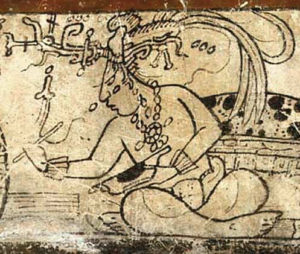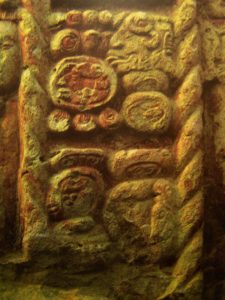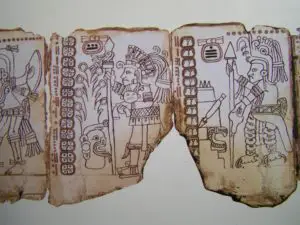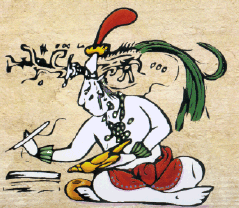Podcast: Play in new window | Download
Subscribe: Apple Podcasts | RSS
 In this episode we will talk about the beautifully enigmatic writing system of the ancient Maya, a civilization that dominated Mexico’s jungles and tropical lowlands for several centuries. After providing some background, we will talk a little bit about the mechanics of the writing system and then go into the fascinating story of how the voices of a long-dead culture came to be heard again through the efforts of a number of linguists, art historians, archaeologists and epigraphers.
In this episode we will talk about the beautifully enigmatic writing system of the ancient Maya, a civilization that dominated Mexico’s jungles and tropical lowlands for several centuries. After providing some background, we will talk a little bit about the mechanics of the writing system and then go into the fascinating story of how the voices of a long-dead culture came to be heard again through the efforts of a number of linguists, art historians, archaeologists and epigraphers.
In all of the New World, the Maya are the only people to have a complete writing system and were able to communicate exactly what was spoken with their writing. Although Maya script flourished during the Maya heyday from about the time of Christ to 900 AD, there has been a discovery of Maya writing at a site called San Bartolo in Guatemala that dates back to about 300 BC. The writing continued in some form all the way through the Spanish Conquest with some scribes producing texts well into the 17th Century. Today the ancient Maya script has survived on the monuments of the ruined great cities of the Maya, on cave walls, pottery, and in 4 precious bark-paper books called codices. For the most part the script is read from left to right and from top to bottom in columns of two. Exceptions occur in small portable items such as vases or jars and in graffiti.
 Other great civilizations of the Americas did not have writing as extensive and as complex as the Maya. The vast Inca Empire of South America, for example, had a system of knotted cords called quipu, which would be considered more of an alternate system of communication rather than a script, and is believed to have had more of an accounting or record-keeping focus. The Zapotecs who lived west of the Maya from 400 BC to 600 BC had a rudimentary interpretive script as did the Olmecs before them. Few examples of Olmec script survive and date to about 900 BC. A basic writing system called Isthmian Script was also used in various places on the Isthmus of Tehuantepec as early as 500 BC and its glyphs are assumed to be word units but their meanings are unknown because they only occur on a handful of texts. In the years right before the Spanish contact with Mexico, the Aztec Empire had a writing system that was semasiographic, that is the Aztecs wrote with signs much like the computer smiley faces called emojis of today. Their texts communicated information without using forms of speech and was not an exact representation of the spoken word.
Other great civilizations of the Americas did not have writing as extensive and as complex as the Maya. The vast Inca Empire of South America, for example, had a system of knotted cords called quipu, which would be considered more of an alternate system of communication rather than a script, and is believed to have had more of an accounting or record-keeping focus. The Zapotecs who lived west of the Maya from 400 BC to 600 BC had a rudimentary interpretive script as did the Olmecs before them. Few examples of Olmec script survive and date to about 900 BC. A basic writing system called Isthmian Script was also used in various places on the Isthmus of Tehuantepec as early as 500 BC and its glyphs are assumed to be word units but their meanings are unknown because they only occur on a handful of texts. In the years right before the Spanish contact with Mexico, the Aztec Empire had a writing system that was semasiographic, that is the Aztecs wrote with signs much like the computer smiley faces called emojis of today. Their texts communicated information without using forms of speech and was not an exact representation of the spoken word.
In writing, if a script has between 20 and 35 signs it is considered alphabetic, much like our own, where letters of the alphabet are combined to form spoken words. If a script has between 80 and 100 signs it is considered syllabic, with each sign representing a sound or piece of the spoken work. If the script has several hundred signs, like Japanese, it is considered logographic, that means the signs or logograms represent meanings and sounds of complete words. The ancient Maya system of writing has around 800 signs and it is a mixture of logograms and phonetic signs. Writing specialists, called epigraphers, have thus classified the Maya writing system as logosyllabic. So, the signs combine sounds and symbols meaning full words or ideas.
 Maya writing has a lot of what is called ployvalence, which exists in every language in the world. It has polyphony, meaning that a given sign has different sound values and can be read differently. In English, the letter “c”, for example, may have several sounds, as in the words “cat” and “city”. This is polyphony. Maya also has a great deal of homophony, in that different signs represent the same sound value. Does this sound confusing? Well, imagine how early archaeologists and epigraphers felt when they undertook the challenge of deciphering the ancient Maya texts. They needed to deconstruct the basic elements of the system first before they could continue with the work of true translation.
Maya writing has a lot of what is called ployvalence, which exists in every language in the world. It has polyphony, meaning that a given sign has different sound values and can be read differently. In English, the letter “c”, for example, may have several sounds, as in the words “cat” and “city”. This is polyphony. Maya also has a great deal of homophony, in that different signs represent the same sound value. Does this sound confusing? Well, imagine how early archaeologists and epigraphers felt when they undertook the challenge of deciphering the ancient Maya texts. They needed to deconstruct the basic elements of the system first before they could continue with the work of true translation.
Our own letter “x” can be examined here. It has different polyphonic meanings. It changes its sound in various words. Listen to the various sounds it can make in these English words: excel, exist, xenophobia. All are written with “x.” Our letter “x” can also be used as a logogram. It can be used to mean multiplication. It can be used to indicate where to put a signature on a document. It can be used to represent an unknown quantity. Finally, it can be used to represent the number 10.
The Maya language is also full of homographs, homophones, semantic determinatives and diacritical signs. The important take-away here is that the written language of the ancient Maya was beautiful in its complexity. Playfulness and artistry were an important part of the system. Its artistic genius lies in how everything was combined. The graphic component of this system is truly amazing.
 There were many ways, for example, a glyph could be written. One sign could be slipped inside another or overlapped with another. Two signs could be blended together, merging their attributes to create meaning. A glyph could be written abstractly or as a head of a human, animal, or god. The Maya scribes disliked repeating themselves and one sound could have 12 to 15 different signs. The visual beauty of the system sprang from this seemingly unending variety. Unfortunately, the artistic dimension of this written communication proved to be one of the biggest and most confusing obstacles in its decipherment.
There were many ways, for example, a glyph could be written. One sign could be slipped inside another or overlapped with another. Two signs could be blended together, merging their attributes to create meaning. A glyph could be written abstractly or as a head of a human, animal, or god. The Maya scribes disliked repeating themselves and one sound could have 12 to 15 different signs. The visual beauty of the system sprang from this seemingly unending variety. Unfortunately, the artistic dimension of this written communication proved to be one of the biggest and most confusing obstacles in its decipherment.
It’s generally agreed that about 80% of all ancient Maya inscriptions can be read phonetically leading to about a 60% interpretation rate. New meanings of glyphs are tossed about and discussed among experts and compared to the corpus of known glyphs which are reexamined and sometimes reinterpreted and given a new meaning. Current Mayanists stand on the shoulders of giants as it was a long road taken to get to our present understanding of this beautiful and mysterious written language.
The story of the decipherment, ironically, begins with a book burning. In 1549 Bishop Diego de Landa arrived in the Yucatan and ordered the burning of all the Maya bark paper books – which amounted to 27 – and the destruction of hundreds of Maya artefacts. There were many Maya scribes who  still practiced the ancient writing system at the time of the book burning, and de Landa had scribes write down what he called the Maya alphabet and described it in his book Relación de las Cosas de Yucatán. For years this “alphabet” was considered nonsense but later, in the 20th Century, it proved helpful to those approaching Maya decipherment from the angle of looking at the signs as being symbols from a spoken language. The first real break in figuring out the Maya writing system happened in the 19th Century when a French scholar came to understand the number system found in many of the Maya inscriptions. Date interpretation followed. In the middle of the 20th Century great breakthroughs occurred with the realization that the writing was partly syllabic, that is, based on spoken sounds. As most of this research was coming from the Soviet Union, from a lone Russian Mayanist named Yuri Knorossov, it was mostly dismissed by scholars in the West as a Marxist/Lenninist plot and not worthy of scientific consideration. However, some epigraphers and Maya researchers went with this idea and built upon it working here and there in various Western universities. Concurrently with the realization that these signs or parts of these signs were sounds was the realization that the writings on the monuments mostly chronicled the events of the elites, which makes sense when you
still practiced the ancient writing system at the time of the book burning, and de Landa had scribes write down what he called the Maya alphabet and described it in his book Relación de las Cosas de Yucatán. For years this “alphabet” was considered nonsense but later, in the 20th Century, it proved helpful to those approaching Maya decipherment from the angle of looking at the signs as being symbols from a spoken language. The first real break in figuring out the Maya writing system happened in the 19th Century when a French scholar came to understand the number system found in many of the Maya inscriptions. Date interpretation followed. In the middle of the 20th Century great breakthroughs occurred with the realization that the writing was partly syllabic, that is, based on spoken sounds. As most of this research was coming from the Soviet Union, from a lone Russian Mayanist named Yuri Knorossov, it was mostly dismissed by scholars in the West as a Marxist/Lenninist plot and not worthy of scientific consideration. However, some epigraphers and Maya researchers went with this idea and built upon it working here and there in various Western universities. Concurrently with the realization that these signs or parts of these signs were sounds was the realization that the writings on the monuments mostly chronicled the events of the elites, which makes sense when you  think about it. In most every civilization on earth rulers have thought to solidify authority and confirm legitimacy by using symbols and propaganda. A Russian-American architect and art historian named Tatiana Proskouriakoff noticed dates corresponding to the lifetimes of individuals and noticed patterns across monuments. At the time this interpretation was considered revolutionary because most Maya scholars were not seeing the writings as being either historical or anything other than symbolic. For the longest time it was believed that this wasn’t even a complete writing system, and this was promoted by one professor, Eric S. Thompson, who vehemently disapproved of the syllabic approach. The 1960s saw many breakthroughs in the field based on interpretation of the dynastic stories represented on the monuments and even Professor Thompson yielded to the new methods of interpretation. Translation after that has proceeded at an exponential pace. It may be of interest to note here that the youngest recipient of a MacArthur Fellowship or “Genius Grant” was the 18-year-old David Stuart in 1984 for his work on Maya epigraphy. Stuart has devoted his life to the ancient Maya writing and has probably contributed more than any other on this subject.
think about it. In most every civilization on earth rulers have thought to solidify authority and confirm legitimacy by using symbols and propaganda. A Russian-American architect and art historian named Tatiana Proskouriakoff noticed dates corresponding to the lifetimes of individuals and noticed patterns across monuments. At the time this interpretation was considered revolutionary because most Maya scholars were not seeing the writings as being either historical or anything other than symbolic. For the longest time it was believed that this wasn’t even a complete writing system, and this was promoted by one professor, Eric S. Thompson, who vehemently disapproved of the syllabic approach. The 1960s saw many breakthroughs in the field based on interpretation of the dynastic stories represented on the monuments and even Professor Thompson yielded to the new methods of interpretation. Translation after that has proceeded at an exponential pace. It may be of interest to note here that the youngest recipient of a MacArthur Fellowship or “Genius Grant” was the 18-year-old David Stuart in 1984 for his work on Maya epigraphy. Stuart has devoted his life to the ancient Maya writing and has probably contributed more than any other on this subject.  Other stars of the Maya decipherment movement include Michael Coe and Linda Schele, among others, and their works are cited below. With many books written on the glyphs and with information widely available on the internet, it is only a matter of time before collectively we will be able to read 100% of the ancient inscriptions.
Other stars of the Maya decipherment movement include Michael Coe and Linda Schele, among others, and their works are cited below. With many books written on the glyphs and with information widely available on the internet, it is only a matter of time before collectively we will be able to read 100% of the ancient inscriptions.
So, why is any of this important? The decipherment of the ancient Maya texts gives us insight into what these people thought was important in their own words. The rise and fall of cities, sweeping astronomical studies, the lives of the kings, the stories of the gods and superheroes, and the chronicling of major events in the Maya city-states is not given to us by Spanish observers or modern-day anthropologists. It is all offered to us by the Maya themselves in their own special way and by using their own voices. No value can be placed on that.
REFERENCES (this is not a formal bibliography)
Breaking the Maya Code by Michael D. Coe
The Maya by Michael D. Coe
Introduction to Maya Hieroglyphs by Harri Kettunen and Christophe Helmke
A Forest of Kings: The Untold Story of the Ancient Maya by Linda Schele and David Freidel
Lost Kingdoms of the Maya produced by the National Geographic Society
